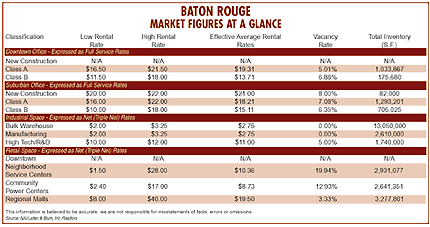DIVERSE ECONOMY DRIVES GROWTH IN BATON ROUGE
Don Cooper
 Although
located just 80 miles upriver from New Orleans, the Baton
Rouge, Louisiana, real estate market shares little with its
larger neighbor to the southeast. The second largest city
in Louisiana, Baton Rouge's economy has many factors in its
favor. The city is the center of state government. It is also
the hub of the state university education system and home
to both Southern University and Louisiana State University
(LSU). A large petrochemical industry provides thousands of
high-paying blue collar jobs. A shrewd former governor, Huey
Long, built a low-hanging bridge across the Mississippi River,
north of the city, assuring Baton Rouge would remain the northern-most
port on the Mississippi able to handle deep-draft ships. Although
located just 80 miles upriver from New Orleans, the Baton
Rouge, Louisiana, real estate market shares little with its
larger neighbor to the southeast. The second largest city
in Louisiana, Baton Rouge's economy has many factors in its
favor. The city is the center of state government. It is also
the hub of the state university education system and home
to both Southern University and Louisiana State University
(LSU). A large petrochemical industry provides thousands of
high-paying blue collar jobs. A shrewd former governor, Huey
Long, built a low-hanging bridge across the Mississippi River,
north of the city, assuring Baton Rouge would remain the northern-most
port on the Mississippi able to handle deep-draft ships.
In January 2002, the City of Baton Rouge will begin construction on a
new $55 million convention center. The project will be constructed on
the riverfront at the intersection of Government Street and River Road.
Funds to construct it come from a bed tax, state capital outlay and sales
tax rebates from the hotels in the parish, according to Davis Rhorer,
an executive at the Baton Rouge Downtown Development District.
Today, a growing gaming industry and a business travel market fueled
by government and education are creating a thriving hospitality industry.
It is no wonder many predict that Baton Rouge is well on the way to becoming
the largest city in Louisiana. The city's 15 consecutive years of employment
growth bear testimony to the resilience and diversity of Baton Rouge's
economy. Against that backdrop, occupancy levels in the office, industrial
and retail centers remain strong.
Job Growth
Despite a drop in government employment, Baton Rouge continues to show
positive job growth. Jimmy Lyles, chairman and CEO of the Greater Baton
Rouge Chamber of Commerce, says, "The metropolitan area has experienced
an overall net job growth of 1,600 jobs over the last 12 months. Taken
together, construction, retail trade and service sectors showed a 12-month
increase of 5,600 jobs. This non-governmental 12-month job gain leads
all other Louisiana metropolitan areas."
Lyles noted that a considerable amount of this private sector growth
was offset by an unexplained 12-month reduction of 4,000 government jobs.
LSU economist Dr. Loren Scott predicts that 27 percent of all jobs statewide
will be created in Baton Rouge during the coming year. Growth in the telecommunications
and technology arenas in the city have contributed to the recent gains.
Retail
The area's oldest retail mall, Bon Marche, is under redevelopment by
Winward Properties and will be renamed Bon Carr? Town Center. Overall
retail occupancy in Baton Rouge stands at 88.3 percent. Older neighborhood
centers have the highest vacancies and the regional vacancy rate stands
at 11.5 percent. A number of big box users have entered or are in the
process of entering the market. Sam's Club, Bed Bath & Beyond, Old Navy
and Target have all initiated projects, and there is strong speculation
that Wal-Mart will enter the mid-city area. Albertsons continues to lead
the region in grocery sales.
Where initial projections were pointing toward 40 percent office and
60 percent retail, the market has reversed those projections. Nearly 100
percent of office users are telecommunication and/or technology companies,
a result of the presence of major fiber optics at the site and below-market
rates in the range of $8.
Office
The overall office market remains strong with 93 percent occupancy of
Class A space. There has been a weakening in Class B and garden office
space, due in part to previous tenants building or buying their own office
space.
Rob Hebert, an office specialist with NAI/Latter & Blum, says that while
Class A leasing activity has slowed in 2001, the market has maintained
a state of equilibrium, with a lack of new tenants but no large spikes
in vacancy.
One of the largest office construction projects in Louisiana is rising
from the ground in downtown Baton Rouge. Capital Park, a major project
by the state of Louisiana, will provide centralized space for state workers
who are now scattered throughout Baton Rouge in leased space. Rhorer says
the complex will have a dramatic impact on the downtown area.
"Capital Park represents an investment of over $135 million in buildings
already completed or under construction," says Rhorer. "That includes
1 million square feet of new office construction and an additional 1 million
square feet of parking. Another 500,000 square feet of parking and nearly
1 million square feet of office space are currently under design." Rhorer
says that when complete, the Capital Park project will bring more than
2,000 jobs to the Baton Rouge central business district.
However, Capital Park will create vacancies across the city as buildings
are completed and state workers vacate leased properties. No single area
is expected to be hit particularly hard, but pockets of office vacancies
may spring up around the city.
One exception to the equilibrium in the office market is the Sherwood
Forest area. Community Coffee, a substantial presence in Baton Rouge,
built a new facility, putting 25,000 square feet of lease space on the
market. Nearby corporate consolidations placed another 30,000 square feet
on the market. All told, nearly 60,000 square feet of office vacancies
exist in the Sherwood Forest area.
Industrial
The industrial market remains in balance with a 4 percent vacancy factor.
Notably absent in the market is the availability of large bulk industrial
space; almost all existing bulk space is leased, albeit much of it for
short term, by chemical and petrochemical users. Demand in the small office/warehouse
(2,000 to 10,000 square feet) sector remains strong and is approaching
100 percent occupancy. Land sales for these warehouse developments are
more than $4 per square foot and continue to escalate slowly. Some industrial
demand has shifted south to Ascension Parish due to more affordable unimproved
property, in the range of $2 per square foot.
The Mississippi River, a barrier for many years to the west, is no longer
a limiting factor in development. Lower land prices in the west Baton
Rouge area, now in the $1 per square foot range, are luring many industrial
users to the west bank of the river. These lower land prices, coupled
with lower taxes, ease of development and accessibility, have spurred
construction of almost 1 million square feet of warehouse/distribution
space in west Baton Rouge during the past 12 months. Another 800,000 square
feet is planned for 2002.
Investment Sales
Several years of rising prices for investment properties have prompted
many investors to take advantage of IRS Section 1031 property exchanges
to defer their tax liability upon sale. But bargain properties to exchange
into are hard to come by in Baton Rouge.
That's the view of Austin Earhart, an NAI/Latter & Blum commercial specialist
in Baton Rouge, who recently brokered several investment sales in the
capital city.
"Baton Rouge continues to be a high-demand market for investment properties,"
said Earhart. "This strong demand, coupled with a shortage of suitable
investment vehicles and rising prices, is leading to the re-development
of many older areas."
Investors continue to demand higher yields from projects, while sellers
are seeking to maximize profit. Expect investment activity to remain flat
for the near term. Eventually, says Earhart, "if investment properties
are not generating sufficient cash, either investors will walk away or
values will have to be adjusted to meet investor expectations. Over the
next 12 months, I expect that prices throughout the area may soften to
accommodate those pressures."
Multifamily
Apartment construction has boomed in the latter half of the 1990s, with
nearly 20 new communities and over 3,500 apartments constructed since
1995. During the same period, as many as 750 out-of-service units have
been refurbished and restored to service.
The trend toward more apartments seems certain to continue for the foreseeable
future, with seven communities totaling nearly 1,600 units scheduled to
come on line between 2001 and the end of 2003. The largest of the new
communities is the 433-unit Southgate Towers, a project by the Baton Rouge-based
R.W. Day Company. Planned for Nicholson Drive south of LSU, this high-rise,
luxury development is slated to open in 2002. Lakeside Apartments, another
luxury development planned for the Millerville Road area, will place an
additional 396 units on the market.
While vacancy rates had remained fairly constant despite the construction,
the market is now feeling the effects of the building boom. Linda Jackson,
a vice president with Latter & Blum Property Management, says the hardest
hit area is near the LSU campus, where significant vacancy rates -- once
unheard of -- are suddenly the norm.
"We've gone from very low vacancy rates near LSU to very high vacancy
rates for the fall 2001 semester," says Jackson, "and numerous properties
experienced 25 to 30 percent in vacancy." Jackson attributes the drop-off
to a large number of new units in the area. In addition, more than 200
units went on the market for sale as townhomes and have sold out. An additional
number of townhome units for sale are being built on Burbank and will
further impact the LSU market.
The number of apartments for seniors and assisted living units have also
increased significantly. Ten new facilities or expansions representing
more than 500 new units aimed at seniors have come on the market in the
past 4 years. Despite the new construction, waiting lists and medium to
high occupancy levels are common. Jackson notes, however, that the typical
retirement resident is getting older and less independent. As the market
gets more competitive, she says, "it is only the facilities that are well
managed, offer numerous amenities and have the service packages required
for aging in place that will succeed. The food service and professional
staff will also play a key role in the success of retirement facilities
in coming years."
Don Cooper is the editor of NAI/Latter & Blum Market News and Views.

©2001 France Publications, Inc. Duplication
or reproduction of this article not permitted without authorization
from France Publications, Inc. For information on reprints of
this article contact Barbara
Sherer at (630) 554-6054.
|
